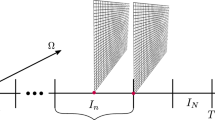Abstract
We study the method which is obtained when a multi-grid method (in space) is first applied directly to a parabolic intitial-boundary value problem, and discretization in time is done only afterwards. This approach is expected to be well-suited to parallel computation. Further, time marching can be done using different time step-sizes in different parts of the spatial domain.
Similar content being viewed by others
References
A Brandt,Multi-level adaptive finite-element methods. I. Variational problems. In:Special Topics of Applied Mathematics (J. Frehse, D. Pallaschke, U. Trottenberg, eds.), North-Holland, 1980, 91–128.
Ph. Brenner, V. Thomée and L. B. Wahlbin,Besov Spaces and Applications to Difference Methods for Initial Value Problems. Springer Lecture Notes in Mathematics 434, 1975.
K. Burrage and J. C. Butcher,Stability criteria for implicit Runge-Kutta methods. SIAM J. Numer. Anal. 16 (1979), 46–57.
C. Corduneanu,Integral Equations and Stability of Feedback Systems. Academic Press, 1973.
M. Crouzeix, Sur la B-stabilité des méthodes de Runge-Kutta. Numer. Math. 32 (1979), 75–82.
W. Hackbusch,Parabolic multi-grid methods, In:Computing Methods in Applied Sciences and Engineering, VI (R. Glowinski, J.-L. Lions, eds.), North-Holland, Amsterdam, 1984.
W. Hackbusch,Multi-Grid Methods and Applications. Springer-Verlag, Berlin-Heidelberg, 1985.
E. Hairer, G. Bader and Ch. Lubich,On the stability of semi-implicit methods for ordinary differential equations. BIT 22 (1982), 211–232.
E. Hairer and Ch. Lubich,On the stability of Volterra Runge-Kutta methods. SIAM J. Numer. Anal. 21 (1984), 123–135.
P. J. van der Houwen and H. B. de Vries,Preconditioning and coarse grid corrections in the solution of the initial value problem for nonlinear partial differential equations, SIAM J. Sci. Stat. Comput. 3 (1982), 473–485.
E. Lelarasmee, A. E. Ruehli and A. L. Sangiovanni-Vincentelli,The waveform relaxation method for time-domain analysis of large scale integrated circuits. IEEE Trans. CAD 1 (1982), 131–145.
U. Miekkala and O. Nevanlinna,Convergence of dynamic iteration methods for initial value problems. Helsinki University of Technology, Report Mat — A230 (1985), to appear in SIAM J. Sci. Stat. Comp.
O. Nevanlinna,Matrix valued versions of a result of von Neumann with an application to time discretization. J. Comp. Appl. Math. 12 & 13 (1985), 475–489.
A. R. Newton and A. L. Sangiovanni-Vincentelli,Relaxation-based electrical simulation. IEEE Trans. CAD 3 (1984), 308–331.
R. E. A. C. Paley and N. Wiener,Fourier Transforms in the Complex Domain, Amer. Math. Soc., Providence, R.I., 1934.
K. Stüben and U. Trottenberg,Multigrid methods: Fundamental algorithms, model problem analysis and applications. In:Multigrid Methods (W. Hackbusch, U. Trottenberg, eds.). Springer Lecture Notes in Mathematics 960, 1982.
A. Zygmund,Trigonometric Series, Cambridge University Press, 1959.




